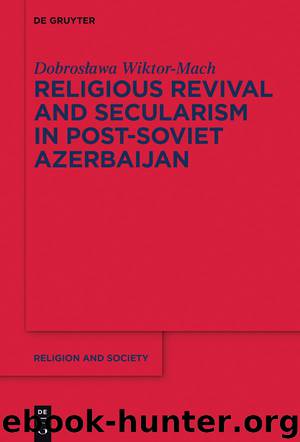Religious Revival and Secularism in Post-Soviet Azerbaijan by Dobrosława Wiktor-Mach

Author:Dobrosława Wiktor-Mach
Language: eng
Format: epub
Publisher: Walter de Gruyter
Published: 2017-05-15T00:00:00+00:00
The questions I find fascinating in studying contemporary Islam are its internal heterogeneity, flexibility and dynamics. Like in other world religions, Islamic scriptures allow for multiple interpretations. The religious revival brings those models of religions into open competition. To understand this religious pluralism, as it manifests itself in discourses and practices of Muslims, we need to identify the main groups, their leaders and activists. Besides, it is crucial to understand their types of capital (in Bourdieu’s sense), strategies used in the intra-religious competition, the power relations, and geopolitical conditions.
In the contemporary public discourse in Central Asia and the Caucasus Islamic pluralism is frequently presented as an opposition between “traditional” and “fundamentalist” groups. This dichotomy still prevails in the contemporary public discourse, among journalists on one side, and analytics on the other. Generally, the former term refers to the “cultural Muslims,” who follow local customs and keep the conventional social systems. The latter category, a synonym to “Wahhabi,” describes those observant Muslims who contest the religious and social status quo. These schematic categories to some extent replaced older dichotomies, such as “official” (related to the state) Islam versus “unofficial” (independent), “high” (represented by urban elites) and “low” (rural), or “pure” (focused on the Scriptures of Islam) and “syncretic” (containing non-Islamic elements)25. While all these terms transfer some characteristics of religious forms, in the contemporary context of post-communist countries exposed to global and influences, such dichotomies are not of much use. A more fruitful way is to account for the present religious situation by employing the concept of discursive traditions in Talal Asad’s (1986) interpretation. Such perspective allows us to appreciate a highly heterogeneous Islamic culture in its local context. As it was mentioned in the first chapter, the history of Islam in the Caucasus was extremely complicated and witnessed a large variation of religious branches and sects which either coexisted or competed with each other to win support of the local population. To some extent, today’s religious diversity resembles that from the past.
In contemporary Azerbaijan, the most visible division that is evident in everyday life is between the secular attitude (as characterized in the previous chapter) common to the majority of local Muslims and the attitude of Islamic piety, which is promoted by a wide range of religious movements, groups, institutions and individual actors. The ‘religious’ minority is also extremely diverse. There are Shia pious communities, embracing conservative, liberal, political, or reformist discourses and Sunni pious groups which are further differentiated into orthodox, Sufi, Turkish, and inspired by Arabic countries—the Salafi interpretation of Islam. Moreover, Islamic modernism, an identifiable historic tradition, is being constantly redeveloped by a few distinct actors, mainly Muslim Azerbaijani intellectuals. Even though its influence in society at the moment is rather limited, the modernists may possibly respond to the demand for local religious authorities in the future.
As some experts argue (see, e. g., Peuch, 2004), Azerbaijan represents Islamic diversity to a larger extent than any other Muslim post-Soviet republic, because only in this country Turkish, Iranian, and Saudi Arabian models of Islam have similar “market share.
Download
This site does not store any files on its server. We only index and link to content provided by other sites. Please contact the content providers to delete copyright contents if any and email us, we'll remove relevant links or contents immediately.
4 3 2 1: A Novel by Paul Auster(11812)
The handmaid's tale by Margaret Atwood(7465)
Giovanni's Room by James Baldwin(6820)
Asking the Right Questions: A Guide to Critical Thinking by M. Neil Browne & Stuart M. Keeley(5362)
Big Magic: Creative Living Beyond Fear by Elizabeth Gilbert(5361)
Ego Is the Enemy by Ryan Holiday(4964)
On Writing A Memoir of the Craft by Stephen King(4671)
The Body: A Guide for Occupants by Bill Bryson(4591)
Ken Follett - World without end by Ken Follett(4449)
Bluets by Maggie Nelson(4274)
Adulting by Kelly Williams Brown(4243)
Eat That Frog! by Brian Tracy(4167)
Guilty Pleasures by Laurell K Hamilton(4125)
White Noise - A Novel by Don DeLillo(3836)
The Poetry of Pablo Neruda by Pablo Neruda(3823)
Fingerprints of the Gods by Graham Hancock(3744)
Alive: The Story of the Andes Survivors by Piers Paul Read(3739)
The Book of Joy by Dalai Lama(3709)
The Bookshop by Penelope Fitzgerald(3624)
